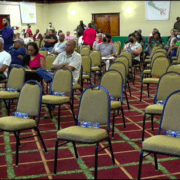Black Immigrant Daily News
Last week’s public consultation on Waterloo Investment Holdings’ proposal to construct a cruise terminal and expand the cargo facilities at the Port of Belize Limited compound was lengthy and tense.
BELIZE CITY, Wed. Sept. 7, 2022
by Marco Lopez
The public consultation held last Thursday at the Best Western Biltmore Plaza to address concerns and questions surrounding Waterloo Investment Holdings’ proposal to construct a cruise terminal and expand the cargo facility at the Port of Belize compound in Belize City lasted a little over 4 hours, with the question-and-answer section of the meeting occupying most of the allotted time. At the end of the session, though, there were questions and concerns that lingered—with some members of the public pointing to huge information gaps and uncertainties that lie between the lines and below the surface of the claims being made by the company.
New EIA, but offshore option still cited?
The new Environmental Impact Assessment that was considered at the public consultation session has been touted as a response to the concerns of the public about the offshore dumping of dredged material that had been proposed in a previous EIA, submitted in 2019, which had been rejected by the National Environmental Appraisal Committee. The current EIA that is being reviewed, which was prepared by the Nextera and Piedroba consultancy groups on behalf of Waterloo Investment Holdings Limited, purportedly (according to project lead, Piedroba’s Luis Munoz) included additional data that had been requested by the NEAC, and it was said that the option of offshore placement had been removed entirely from the proposal. But according to Vice–President of OCEANA and Senator for the NGO community, Janelle Chanona, that option perhaps was not altogether removed, since references to it as an option surfaced disturbingly at certain spots in the EIA. Chanona noted during her presentation that although Waterloo has been claiming it is no longer considering offshore dumping, references to that option—tucked between pages and pages of assurances that no such dumping would take place—seemed to suggest otherwise. In fact, Chanona pointed to one part of the document which described it as a “necessary option”. “On page 168, offshore is still mentioned as an offshore disposal option, and later at the top of page 227, it is referred to as a necessary option,” Chanona said.
The portions of the document which contain such references to the company’s intention to still consider an offshore option include Section 4.3.3, which outlines, under the heading, “The Assessment of Dredge Material Disposal Option,” four alternatives for the disposal of the dredge material. These include: 1. Placement on PoBL and adjacent lands at the port, 2. nearshore placement in adjacent water, 3. in open sea far offshore, and4. A No Action Alternative.
The first paragraph on page 227 states, “Because of the volume of material to be dredged and the available area on land, a combination of disposal areas will have to be considered, including deep-sea disposal. Material to be dredged contained very low or negligible amounts of heavy metals, mineral oils, and polyaromatic hydrocarbons and are well within the acceptable levels for deep-sea disposal as required internationally. ”
The document further makes mention of how much cubic meters of dredged material can be disposed of through onshore and nearshore placement: 3.5 million cubic meters onshore and 4.5 million cubic meters nearshore—which amounts to a total of 8 million cubic meters of dredged material. However, only 7.5 m cubic meters is cited in other parts of the EIA. The section states, “it must be considered that 500,000 m³ extra of over dredge materials by volume is required to reach design level, as there typically are vertical over dredging tolerances related to dredging campaigns.”
The question remains: where will this extra half cubic meters of dredge material be placed? The developers have unequivocally denied that any material will be placed offshore despite the option still being mentioned in this EIA.
“We can say unequivocally that there is absolutely no request of DOE to permit offshore disposal. It’s not something that we are gonna do, and it’s not something that we are asking to do,” Luis Munoz said. “Unequivocally we are stating that we are not seeking anything to do with offshore placement. It’s been unequivocally completely withdrawn,” he added at the public consultation. Those were his words—a seemingly non-legally binding statement that appeared to be at odds with what was stated in black and white in the EIA document.
Notably, according to Kenrick Gordon, CEO in the Ministry of Sustainable Development, Climate Change and Disaster Risk Management, the developers were instructed, via a terms of reference, to provide three options for the placement of dredged material and select the preferred option, and also to provide three options for the containment of the material.
Nearshore/Onshore Disposal: The new option?
The developers have pointed out that lands owned by the PoBL will be used to place dredged material both onshore and nearshore and have suggested that the 3 to 3.5 million cubic meters of dredged material that will be placed onshore will be used as landfill and construction material for the project. They have also suggested that the material will also be made available for the public to use as landfill to clear the onshore location in the event more dredging is necessary for the future—without providing any details about how much landfill would be distributed. According to a statement released by OCEANA this week, “the volume and impacts of such a program are not stated nor assessed.”
It is also to be noted that the contained area in which the company plans to place dredged material, which is to be enclosed by geotextiles, silt screens, and turbidity curtains, has been expanded to 1200 acres in the marine environment adjacent to the port compound.
But there are serious questions currently about whether or not it would be possible to isolate dredged material by means of the geotextiles at this quantity and prevent any seepage into the open sea to avoid the risk of impact on the Belize Barrier Reef system. At the public consultation, Rodrigo Ferreira Modernel, the Regional Manager for Boskalis, a dredging and offshore contracting and marine service company, asked the developers to refer to 5 instances where geotextiles were used at this level and effectively contained the dredged material, citing the high risk of structural failure and the lack of a proper risk assessment within the ESIA.
The panel representing Waterloo did not furnish such examples. No direct references were identified by the German consultant who replied to the question, Kris Baert, who joined the consultations on behalf of the developers via Zoom. He only gave examples of general usage of geotextiles and said that while the method has been widely used, this methodology being used in Belize is new.
“What’s new in this case is what we proposed, and therefore it’s not something we thought of lightly,” Baert said. He said that the company will stretch out the placement of the material in the 1200-acre coastal area designated for nearshore dumping, where about 4 million cubic meters of dredged material is to be placed. He said that the seabed over the area would be lifted around 1 to 1.5 meters after the placement is complete, and the geotextiles would be connected by sections.
“The containment barrier we will put in front, that is not going to hold back a wall of sediments or liquids when it raptures that it flows uncontrollably, that’s not going to happen,” Baert claims. A question was also posed on the effects of turbidity that may arise from the placement of dredged material in the area. Baert said that a silt screen floating on the top of the water will prevent the floating turbidity from escaping into the open ocean.
Baert was cut off by the master of ceremonies before he could complete the answer to the question posed to him, but as mentioned, did not cite one project that has used this method proposed by the developers effectively and without incident. The nearshore placement will remain in the marine environment, so any structural failure of the geotextile option across the 1200 acres span will cause potential contamination of the dredge spoils within the wider marine ecosystem and ultimately the Barrier Reef.
OCEANA, in a statement issued this week, also pointed to the fact that what would take place if a natural disaster such as a hurricane occurred was not addressed in the document.
No Action Alternative…
Is the risk of structural damage to the geotextile material that would hold dredged material in the nearshore placement area too great of a threat to the Belize Barrier Reef Reserve System? That is what attorney Sharon Pitts asked the panel. She submitted that the No Action Alternative is the only viable option given the value of the reef for Belizeans, and as a World Heritage Site. (In 1996 UNESCO added the Belize Barrier Reef Reserve System to the list of World Heritage Sites).
“We disagree with the fact that you’re asserting that the only viable alternative is the no action alternative; the truth is, we all very strongly believe in the validity of science; we believe in engineering and we believe in the capacity of good quality engineering to mitigate risk,” Luis Munoz said. “We are significantly further from the reef than is being represented,” he went on to claim.
What about further dredging?
Damien Goff, a project and operations manager for Out Island Construction and Development Limited, one of the longest operating and most respected marine construction and dredging firms in Belize, posed questions about the issue of consistent siltation. This, he says is a longstanding issue for the port, since geographically, it is located between two tributaries.
“Mr. Lane and anybody else who is familiar with the Port of Belize knows that the single biggest problem facing that facility is its geographic location, sitting between the mount of two tributaries that discharge everything into that bay and wash this way. Everything from 6 Miles Bridge, the Feinstein Marine, all the way up to the port, everything just silts up,” Goff stated, asking what plans the developers had for continuous dredging and the placement of the dredge materials.
Luis Munoz replied by saying that the majority of the material that is placed onshore will be used as fill and whatever is not used for fill by the port will be made available to the public for use.
“Our expectation is that shortly after the construction of the port the upland cells will be empty.” He shared that with any further dredging there will be a place for the dumping of dredged material, saying a maintenance dredge could easily be pumped into the port’s upland.
“So, it is anticipated in the future,” Munoz noted.
He claimed, however, that the channel was last dredged in 2001, saying that the channel itself and the pier head have had “virtually no shoaling.” Goff, replied, however that to the best of his knowledge, smaller-scale dredging operations were conducted between 2010 and 2012 in the turning basin.
“There was a large-scale one back in ’01 yes, and then there was something done, I wanna say something between 2010 and 2012, where they had to redo some of the stuff in the turning basin, because that’s where the problem occurred. When they did it, they took it to 10 meters and earlier in the presentation you said that we are now at 7.35 (meters) or something like that in the turning basin. That’s reflective of the fact that there is continuous siltation that going to happen because the port itself, while it’s been there for 40 years, it’s in geographically the worst location that it could be in Belize,” Goff noted.
One member of the panel insisted, however, that “significant bathymetric studies [were] done …” and that since 2001 “there has been no maintenance dredging performed in the last years at all.”
Disease outbreaks—a real possibility?
Near the end of the session, Tom Greenwood, president emeritus of the Federation of Cruise Tourism Association of Belize (FECTAB), called for the country’s health authorities to look into the possible threat of an outbreak of viruses that could be embedded in the soil that Waterloo plans to dredge.
He pointed to the outbreak of Yellow Fever that ravaged the colony about 100 years ago after Governor Roger T. Goldsworthy endorsed the dredging of canals in Belize City and pilled the material on the banks of South Canal, causing the epidemic that later claimed his wife.
Greenwood did rightly point out that no mention of the possible health risks that can arise from the dredged material was looked at comprehensively in the new EIA.
“Don’t you think for a moment that it is possible that we could be faced with a massive health issue? You have to involve the health authorities if you are going to mess around with the area. ” Greenwood said. It is worth noting that a representative from the Ministry of Health holds a seat on the NEAC. Also, in the EIA, some short-term Health and Social well-being Impacts are mentioned, but none pertaining to the dredged material.
Last week, Greenwood submitted a petition signed by over 20,000 Belizeans who are asking the government to deny approval of the project proposed by Waterloo. Notably, FECTAB has openly supported the Feinstein family’s Port Coral development at Stake Bank.
Non-tendering option approved?
A representative of the Feinstein family, Geren Simonian, claimed during his presentation at the public consultations that the causeway proposed to connect Stake Bank’s Port Coral cruise facilities to Belize City has been approved and is on the construction calendar during his presentation at the public consultations. This is despite a statement by the CEO of the Ministry of Sustainable Development, Dr. Kenrick Williams, that the causeway is still “being reviewed.”
He noted that the premise of Waterloo’s project is that there is no non-tendering option in the country today, but Simonian said that Port Coral’s causeway is the best potential option for the cruise industry in Belize, since that ride along the causeway would be over Belize’s signature turquoise waters, not the brown muddy waters of the coast, driven by the turbidity of the tributaries near the PoBL. (The elimination of the tendering process—which involves the use of small boats to ferry cruise passengers to the mainland—is the goal of the major cruise lines and, indeed, cruise destinations across the world.)
Simonian stated, “I would like to make it crystal clear that there already is a project being completed, Port Coral, in the next few months; it 100% has a causeway approved and permitted to be built from Port Coral to the Drown Caye development and from Drown Caye to the city.”
He posited that the purpose of Waterloo’s cruise port project has nothing to do with tourism.
“It has to do with something else. The cargo port has had 15 years in receivership to get upgraded; it’s interesting how today is when they choose to do this, so I will make it crystal clear that that causeway already exists and is on the construction calendar,” he said.
Two Thousand Five Hundred Jobs?
One of the claims being made by the Waterloo developers is that 2,500 jobs will be created through the construction and operations of the port. It is a claim that is being repeatedly made to secure the support of Belizeans. According to Dr. Dionne Chamberlain-Miranda, who is a consultant for Waterloo, the company has drafted a hiring agreement which stipulates that 10% of the jobs that are created must be given to residents of Port Loyola. Chamberlain-Miranda said that they went into the community and held consultations with the residents of Jane Usher, who requested a guarantee of job availability.
She said that they will utilize a sort of grievance mechanism to rectify any issue that may arise between the residents and potential employers.
But there are questions about whether such a claim is just a lure to win project approval. In a statement issued this week, OCEANA’s Vice President, Janelle Chanona, told 7News: “it cannot be that we are using job creation and development to justify these decisions if we don’t have clarity on what type of jobs are we talking about, what type of development agenda we’re talking about..”
Wendell Lamont, a resident of Port Loyola and community activist with a degree in natural resources management, is also a business owner in the area.
“You’re hiring a lot of people, and you are bringing this big business into our neighborhood. We want jobs – but we are also entrepreneurs; like I said I own my own business. We are looking for opportunities to become partners in this thing as well, we just don’t want to be outside the doors, fighting for the crumbs. We want to have seats around the table,” Lamont said.
He also called for a seat around the monitoring table.
“How could we, as in local grassroots people from Port Loyola, get on these monitoring bodies that you guys will have to make sure that everything goes smooth and that the promises that you made to us will be delivered to us?” Lamont asked.
“The cruise village that we envision is an authentic cruise village that is driven by authentic artisanal efforts,” he said.
There are lingering questions, however, about how many and what type of jobs would really be created, and the types of working conditions that would exist.
The company proposing the project has, via the Port of Belize Ltd., arguably demonstrated how it treats workers. There are concerns among some that PBL’s treatment of the stevedores might provide a glimpse into how the company will respond to workers’ requests for fair wages and better working conditions, as well as how reduction of staff could be handled.
The president of the Christian Workers Union, Evan “Mose” Hyde, made mention of how the PBL’s treatment of the stevedores provides insights into what type of work conditions would exist at the Waterloo cruise terminal.
“In a couple of days, you and I will be in court. We will be in court, Mr. Lane, because you are – and the organization, not you personally, but Waterloo/PBL took it upon themselves to take up a side legally with resources to prevent one and a half million dollars from reaching its own employees. Now I understand that there is going to be about – I don’t know what the promise is, 2500 jobs. I guess, in the future through Waterloo/PBL. We are talking millions and millions of dollars in Port Loyola and into Southside, but here we had a little chump change, because of the struggle, because of the pressure, and you know where it was going to be spent? Right there, right there inna Port, right deh inna Southside, Mr. Lane. My question is to highlight these things, that we going to be in court on September 13. On October 3, we are going to have another court case because again, Waterloo/ Port of Belize is suing the very membership organization and their reps., and their executive for a million dollars,” Hyde pointed out to the CEO of PBL.
He said that the toxic relations between the employer and its employees go beyond the lawsuits, reminding the panel that in 2020, 35 employees of PBL who were members of the CWU—one of whom was a pregnant worker—were fired in the middle of the pandemic, a crushing blow to their families. Those persons were reportedly fired via text message, (The pregnant worker was later rehired after the company discovered it was illegal to terminate a person in her condition.)
He also outlined that the union spoke to the Director and CEO of Waterloo Investment Holdings, Stewart Howard, to relay to him the urgent need for a bulk storage facility in order to hold on to the business of ASR, who was at the time mulling a transfer of its sugar-loading operation from the PoBL facility to the Big Creek Port. The prospect became a reality just months later, resulting in upward of $30 million dollars in losses of potential lifetime earnings for the stevedores, said the CWU president.
“Mr. Steward said to us, there is not going to be bulk storage unless I have my cruise terminal. So, you know what happened about 6 months after that? ASR signed a deal with GoB and IDB for 30 million dollars and went down to Big Creek and took $30 million dollars worth of earnings out of Port Loyola, and out of Southside,” Hyde said.
He highlighted that the company’s new CEO, Andy Lane, has for the first time since the takeover of the port by a Belize Bank- affiliated receivership, emphasized safety in the workplace
“Could you imagine, Waterloo/Port of Belize has been in charge for a decade, and we didn’t get the sense of commitment to safety until last year, true, when you (Lane) come, when you come I will give you your credit. But I will say that I want to hear how it is that we are going to just completely transform that energy because I think you would concede that it is a very toxic relationship we’ve had. How are we going to transform that now miraculously? Because I cannot understand, how a minister of government can get up on the microphone and say they are going to support a project 500%. I can’t understand, because it is one thing to say that you support this project in principle, but you would have to at least add that I support the project in principle but you guys will have to do better by your workers. You will have to do better with your union. Again, with all due respect to the Minister, he is wrong,” Hyde said, again asking what will be done to ensure that the toxic relationship is not a template for the type of work relations that would exist at a Waterloo cruise port.
PoBL CEO Lane agreed that the relationship between PBL and its employees past could have been a lot better and there are things that occurred during the receivership that are regrettable. He also thanked Hyde for recognizing some positive changes during his time at the helm.
“My strong belief, and I think we have shared opinions here, is that we want to have happy employees. We want to have employees – we want to create opportunities where our employees could speak to us, where we can work together for a much better win-win future.” Lane said.
Lane remarked that he personally believes, on the basis of his interaction with Hyde over the past 18 months, that they can achieve those goals together. He made no mention of the two lawsuits against the union, however.
“I would very much believe that the experience of our existing staff and our future staff, in the future is going to be significantly better than it ever has been in the past. That’s certainly my ambition,” Lane said.
Two Port Loyola reps support Waterloo’s cruise port
Notably, as alluded to by Hyde during his presentation, PUP area representative for Port Loyola, Gilroy Usher has come out publicly in support of Waterloo’s proposed construction of a cruise terminal at the Port of Belize on various occasions, pointing to the economic boost he thinks it will bring to the very impoverished constituency he represents. He said that while he is 200% for the protection of the environment, he is 500% in support of the project because of the new jobs it will create.
“The reason why Northside is in a much better position than Southside is because the people on Northside, they have jobs,” Usher said. “They have jobs—if the people in Port Loyola get job opportunities that this project will bring to their community they will have better streets, better housing,” Usher went on to claim.
A similar sentiment was echoed by his political rival, UDP standard bearer for Port Loyola, Philip Willoughby, who even called for a bipartisan partnership between himself and Usher to rally their supporters behind the Ashcroft-funded enterprise.
“Provided the four pillars of sustainable development are met, and it is approved by the DOE and other agencies, I would be amiably at this time to say that I would be in agreement to support the project with myself and my supporters to propel the project forward and support it. Provided again that the residents of Port Loyola are the direct beneficiaries of this project,” Willoughby said.
“I hope that Mister Usher being here, let not the political divide stop or let us buck heads with differing views of our respective parties and stand up together and support the project for the people of Port Loyola,” he continued.
Unlike Minister Usher, however, Willoughby did mention the plight of the stevedores in regard to their working relationship with PoBL. A large number of the stevedores working at the waterfront are residents of Port Loyola.
Let the record speak for itself
One of the last at the microphone at the public consultation was YaYa Marin-Coleman, chairperson of the UBAD Education Foundation (UEF). She pointed out that the process was an undemocratic one—noting that members of the public seeking to present their views were not afforded adequate opportunity to do so and were subject to a strict time limit. With over 20,000 signatures handed over to the government calling for a stop to the project, and the environmental community’s stand, there is sufficient public opposition to indicate that the DOE should hold a Public Hearing on the matter. That is the position of Marin-Coleman, and one also hinted at by environmental officer Kenrick Gordon when asked his position on the submission from the petitioners.
It’s worth noting that many of the concerns expressed by the public, and the deficiencies observed in Waterloo’s most recent EIA were summarized in a statement issued this week by OCEANA’s Vice President, Janelle Chanona, who noted that “there are still glaring shortcomings as it relates to the six points the developer had cited as reasons the NEAC denied environmental clearance on December 2021”.
She noted that the “hydrological, economic and social impacts associated with expanding nearshore dumping from 750 acres to 1200 acres remain unclear, unacceptably so”, and she pointed to the fact that the hydrological modeling in the report appears to ignore what effects could be caused by large-scale events (hurricanes, for example), and therefore, she noted, “disaster risk management is completely unaddressed in the ESIA”. She also pointed to what she classified as “arbitrary claims” that were made in the report with “no proof”—including an assertion that the silt that is unearthed during the project “will consolidate in a few weeks to months”.
She then pointed to the fact that although it was stated in the ESIA that the nearshore dumpsite “would be expanded to 1,200 acres into the Sibun Bight to accommodate additional spoils”, OCEANA had discovered, after doing some calculations, that “1200 acres can handle only approximately 3.2 million [cubic meters] and not the 4 to 4.5 million [cubic meters] requiring disposal.”
She further observed that although the company suggested that sediment curtains could be removed after months of consolidation of silt, which would purportedly make the material “erosion resistant”, such an assessment was not done empirically—meaning it’s a claim not backed by sufficient evidence. And she also noted that “there is no mention of what will be done to mitigate future shoal erosion after curtains are removed.”
NewsAmericasNow.com










